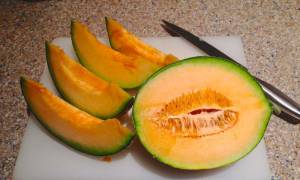Table of Contents
Melons
I would never have thought to grow melons here in the Pacific Northwest. But a Master Gardener said (actually, boasted, I believe) that she grew melons up in Snohomish County, Washington. The idea appealed to me so I shopped seed suppliers for small, short season melons that might have a chance in our relatively cool and wet summer months. I chose the following varieties from Adaptive Seeds:
- Farthest North from Adaptive Seeds
- Oregon Delicious from Adaptive Seeds
- Minnesota Midget from Territorial Seed Company
Planting
I started all in pots in the house. All these guys are slow growers. Next time I'll use a warming pad and grow lights. I tried planting some directly in the soil at both Fall City gardens without success.
Transplanting
In the sandy loam I followed my typical regimen of mixing my basic organic fertilizer into the mounds and then transplanting young seedlings directly.
In the clay soil I added compost, organic fertilizer, and lots of extra lime (agricultural line and Dolomite lime) to allow the plants better access to soil nutrients. I dissolved the lime in water and put it around the plants. Also, I used row cover material to keep in heat and protect from beetles and slugs.
Growing
All of the plants in the sandy loam seemed to require more water to stay vibrant so I watered deeply and a bit more often than I thought necessary.
 Strangely, the ones I planted in sandy loam did poorly. Some of the Farthest North and Oregon Delicious in loam suffered a severe leaf wilt. The Oregon Delicious never put on enough fruit to mention. I left the Farthest North on the denuded vine and harvested four small but nice melons that had good flavor.
Strangely, the ones I planted in sandy loam did poorly. Some of the Farthest North and Oregon Delicious in loam suffered a severe leaf wilt. The Oregon Delicious never put on enough fruit to mention. I left the Farthest North on the denuded vine and harvested four small but nice melons that had good flavor.
The melons (Farthest North and Oregon Delicious) that prospered were in clay soil that had the advantage of an over-wintered rye cover crop. Bugs, slugs and leaf wilt took out all but 3 of the 9 plants here. But I had one Farthest North that yielded a half dozen nice, small melons with excellent flavor. The Farthest North seeds were said to be a mix of different Cucumis melo, but only one variety got to the stage of recognizable fruit.
The Oregon Delicious were the stars, ripening a half dozen large, flavorful melons.
The Minnesota Midgets in either soil grew slowly (or died), a few blossomed, but never got close to ripening any fruit, so they were a bust. The plants were delicate, the flowers pretty, but only a few fruit set and way too late for a change to ripen before cool weather set in.
Harvesting
 The Oregon Delicious were the best surprise. Large melons with great flavor. The skin was a bit thick (but that helped keep the slugs out of the sweet meat). The challenge with them was figuring out when to harvest. One that was a bit over-ripe and one that was a bit under-ripe looked identical. Probing, examining, considering color and texture failed to provide a clear picture of the point of optimum maturity.
The Oregon Delicious were the best surprise. Large melons with great flavor. The skin was a bit thick (but that helped keep the slugs out of the sweet meat). The challenge with them was figuring out when to harvest. One that was a bit over-ripe and one that was a bit under-ripe looked identical. Probing, examining, considering color and texture failed to provide a clear picture of the point of optimum maturity.
"Full slip"
Supposedly it's easy to tell when the Oregon Delicious (and other varieties with netted skin) is ripe because the fruit pulls off easily or “slips” from the vine. It's still a bit of an art to know how much to pull on the vine, but when a melon is really ripe (full slip), it takes almost no pull.
See photos on the Melon photos page.
